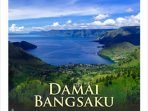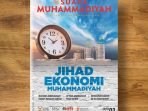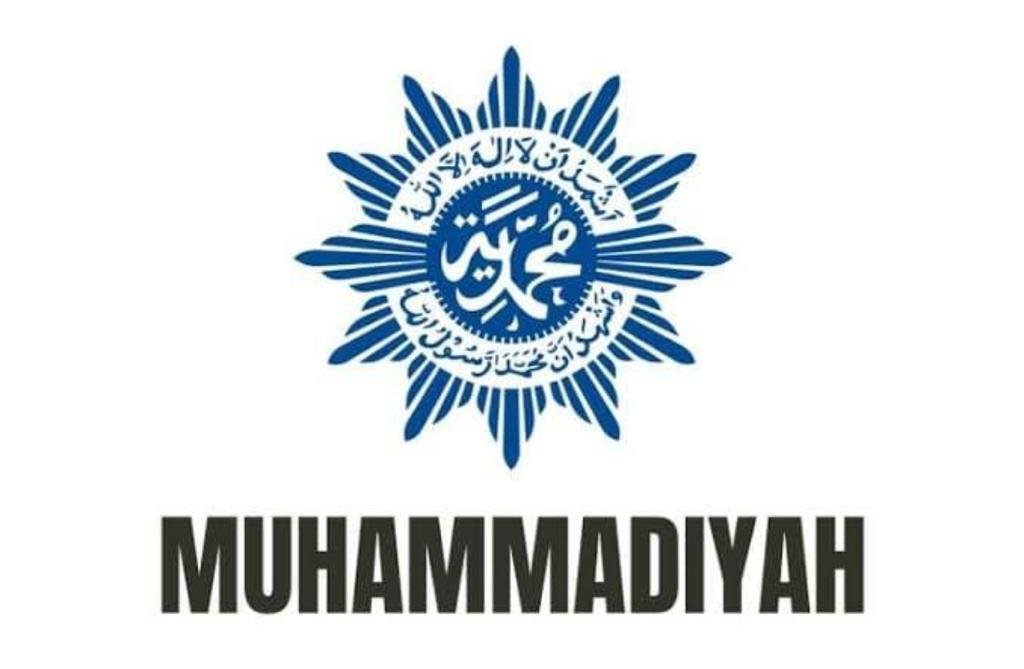MUHAMMADIYAH ALSO MARKED THE NATIONAL PRESS DAY
by Retno Intani ZA

Indonesian press day known as National Press Day (HPN), is commemorated every 9 February to coincide with the anniversary of the Indonesian Journalists Association, based on Presidential Decree Number 5 of 1985.
The Decree stated that the Indonesian national press had a history of struggling and an important role in implementing development as the practice of Pancasila
The Press Council, called Dewan Pers an independent institution in Indonesia as mandated by Law No. 40 of 1999, which functions to develop and protect the life of the press in Indonesia, has stipulated that National Press Days are held every year alternately in provincial capitals throughout Indonesia. The implementation is carried out jointly between the components of the press, the community and the government, especially the regional government as the venue.

In this pandemic era, the implementation of HPN activities was carried out “fully digitally” and although there were several initiatives, HPN pre-condition activities were carried out directly with limited participants.
Various activities of press organizations as constituents of the Press Council include the Indonesian Cyber Media Union (SMSI) built public roads for the community of 750 meters long and 2.5 meters wide as well as the construction of sanitation in the form of buildings for bathing, washing and latrines gifted to Serang residents , Banten Province in need.
There are many efforts to enliven the HPN and its spectrum include appreciation to journalists as had been done by the Muhammadiyah Library and Information Council known as Majelis Pustaka dan Informasi (MPI) Muhammadiyah with its Fachrodin Award.
Muhammadiyah as we all know is the largest modern Islamic mass organization in Indonesia which is very noble for their progress and social role in the field of humanity and nationality.

This organization carries the spirit of national reform and enlightenment was established 33 years before Indonesia’s stated independence on August 17, 1945.
Muhammadiyah has not only become an important part of the history of the nation’s struggling for independence but has continued to give the meaning of independence by moving out the activities in three main fields, namely education, health, and social welfare.
Its cadres are scattered throughout the country. Far from the hustle and bustle of urban areas, far from the center of power, and being in a quiet space, have made hard workers and warriors become an inspiration.
In remote villages, in less accessible areas, it did not discourage Muhammadiyah preachers and organizers to shine light. They are people who are invisible to the eyes, not present in the middle of the arena, but their steps for da’wah have resulted in movement and real contribution.
It would be a mistake if Muhammadiyah is said as an organization with an urban style and only suitable for metropolists.
If traced, it is almost not found in even the most remote areas that do not receive Muhammadiyah da’wah services, whether in the fields of education, health, places of worship, social services, economic empowerment, or anything that might be characteristic of Muhammadiyah cadre services at the most local level. From the West to East Indonesia, Muhammadiyah is present.
The spirit of sacrifice of Muhammadiyah cadres that is evenly distributed from the center to the remote areas, makes such every day inauguration of a Charity Business. Not to mention the innumerable non-physical charities. It is almost difficult to consider how much Muhammadiyah has served this nation and the universe.
In the midst of a charity lake that is increasingly radiating benefits for the country, Muhammadiyah officials at the central level certainly cannot be high-hearted, since every movement of the organization’s steps is none other than the real contribution of local cadres in remote areas who are selflessly struggling with their own way of preaching respectively.
The local cadres are constantly moving to serve in the midst of limited facilities, lack of financial support, difficulties in facing steep terrain, with trips in preaching that must be taken for a very long distance, even they also have to face the tough challenges of local communities that may not necessarily be able to receive enlightenment da’wah as done by Muhammadiyah.
Majelis Pustaka dan Informasi (MPI) or The Information and Library Council is an assembly under the leadership of the Muhammadiyah center which has a vision and mission to build a modern Islamic organization in society through the development of libraries and information.
In the MPI stewardship, there are names that are familiar with the mass media, namely Edy Kuscahyanto, Mohammad Abd Darras, Siswanto Rusdi, Nurcholis Basrori, Imam Prihadiyoko, Wahyudi M Pratama, Rommy Febri, Iwan Situmeang, Rony Tabroni, Najib Burhani, Dinan, Iwan Setiawan, Widyastuti, I myself and many others were commanded by Doctor Mukhlas MT, as Chair of the Muhammadiyah Central MPI.
In the last year of service for the 2015-2020 period, Muhammadiyah Central MPI has a program to raise local Muhammadiyah cadres through reflective writing about the exemplary and contribution of local Muhammadiyah figures to the country. With these writings, it is hoped that they can find and raise local role models born from the womb of the organization so that they can be used as alternative role models for public life in Indonesia.
Starting from that thought, Muhammadiyah Central MPI gave awards to journalists who have worked in writing the roles of Muhammadiyah cadres in remote parts of the country through the mass media.
The award for journalists was named Fachrodin Award. Why the name of Fachrodin?
In Muhammadiyah circles, perhaps the name AR Fachruddin is more familiar than the name Fachrodin without AR.
Yes, AR Fachruddin was a figure whose in the era of President Soeharto was thick with his coolness leading the ummah. AR Fachruddin is the chairman of PP Muhammadiyah for the longest period of time, namely for 22 years, from 1968 to 1990.
Meanwhile, Fachrodin referred to the Fachrodin Award is another figure, called Fachrodin who is a journalist. “This name was inspired by Haji Fachrodin’s progress as a pioneer of the Muhammadiyah press,” said MPI Deputy Chairman Roni Tabroni, who was also one of the initiators of the Fachrodin Award.
Haji Fachrodin is a journalist and Muhammadiyah leader during the early days of Muhammadiyah. Little Hajj Fachrodin named Muhammad Jazuli, was born in 1890. Jazuli grew up in the economic conditions in Kauman, Yogyakarta that were on the rise. As a son of a royal servant, he is also involved in the batik cloth business.
Haji Fachrodin is known as a person who likes to work hard. He not only traded batik, but also started his own printing press, managed a hotel, and set up a cigarette factory.
Professor Haedar Nasir, the General Chairperson of Muhammadiyah Central Leadership concurrently serving as editor in chief of Suara Muhammadiyah magazine testified that Fachrodin was an early generation Muhammadiyah cadre figure who learned a lot from Kyai Dahlan. Even though he did not receive a general education, he grew to become a critical and smart writer which respected by the Dutch at that time and because of his expertise in writing Fachrodin became the first person to lead the editorial department of daily Soewara Moehammadijah.
Fachrodin pioneered the publication of the Soewara Moehammadijah newspaper in 1915 and became the first Hoofdredacteur, while K.H. Ahmad Dahlan sits in the editorial boards with HM. Hisham, RH. Djalil, M. Siradj, Soemodirdjo, Djojosugito, and KRH. Hadjid.
Fachrodin started his career in politics movement when he studied journalism from Mas Marco Kartodikromo. When Mas Marco and several Indonesian journalists published the newspaper called Doenia Bergerak in 1914, Fachrodin was believed to be a permanent writer responsible for providing information in the Yogyakarta area. He is also a member of the Inlandsche Journalisten Bond (IJB).
Fachrodin, with his smartness, cleverness and sharp thoughts, struggled for the fate of the people, including in the effort to raise the resistance of the workers in Yogyakarta to fight for their rights so that he was considered a threat to the Dutch government.
“The sharp thoughts of a Fachrodin gave color to the orientation of thought that was like a leftist Muhammadiyah figure but progressive views for the people as resistance to the Dutch were based from Islamic thought. Fachrodin was also skilled at preaching and was given many tasks by Kyai Dahlan” stated Professor Haedar Nasir to recalled Fachroedin.
“His monumental role was when representing Muhammadiyah for 8 years to study directly the fate of Indonesian pilgrims in Saudi Arabia, who at that time received poor treatment so that from its duties and roles emerged the Muhammadiyah Haj Board. Besides that, Fachrodin was also assigned to following the Islamic Conference in Cairo Egypt. These experiences show the strength of a Fachrodin who was not educated in general but was willing to learn and always mingled in various circles including the socialist figure at that time, namely Suryopratomo. Fachroedin is a cross-border Muhammadiyah figure” Haedar said further.
In 1919, Fachrodin published the weekly newspaper Srie Diponegoro. His writing for this weekly was decorated with illustrations, which show one of Fachrodin’s creativity in the field of journalism.
Haji Fachrodin passed away in 1929. After Indonesia’s independence, the government gave the National Hero award to Haji Fachrodin through the Decree of the President of the Republic of Indonesia number 162 in 1964.
So it seems that the MPI Central Executive, which is dominated by senior journalists, does not want to forget the services of the pioneering Indonesian press among the Muhammadyah circles by holding a writing competition called Fachrodin Award.
As for the Fachrodin Award, after going through a fairly long process, and having extended time for receiving the manuscript, as well as postponing the announcement of the winner of the 2020 Fachrodin Award journalistic writing competition, due to the Covid-19 Pandemic, the committee finally decided to announce the winner on Saturday 19/12/2020 ago.
Actually, the Fachrodin Award was held to participate in celebrating the Muhammadiyah and Aisyiyah Congress. Initially, the announcement and awarding of the 2020 Fachrodin Award, will be held in early July 2020 in conjunction with the Muhammadiyah Congress. However, due to the Covid-19 Pandemic, the Muhammadiyah Central Executive decided to postpone the implementation of the Congress which was planned to be held in Solo, Central Java. This decision also affected the Fachrodin Award committee.
The Fachrodin Award has the theme Muhammadiyah’s progress in advancing the Ummah and Nation.” The idea is want to take a close look Muhammadiyah members, from below, of an area out of the public sight, but they work with enthusiasm” said Edy Kuscahyanto, representative the Muhammadiyah Central MPI Board.
This is also one of the ways to generate Indonesian literacy, and offers a new perspective in seeing Indonesian history. Namely, not seeing what the big people were doing in the center of government or the political center, but providing a place for those who sincerely helped build Muhammadiyah and this country.
There are four topics that are used to provoke journalists’ ideas to reveal cadres who are far from the spotlight of the media. First, history and the role of Muhammadiyah in various regions, the preaching of Muhammadiyah cadres, Muhammadiyah’s charitable activities in serving the people and the nation, and finally the role of Muhammadiyah figures at the local level in various regions in Indonesia.
It is not easy for the jury to assess the journalistic work sent to the committee. The reason is, each of these writings has its own strength and charm. The writings have a writing style that is quite good and understandable. This could be the initial evidence that journalist literacy in Indonesia is able to catch people who work in this silent alley.
In addition, the objects and stories written in the submitted works are also able to arouse attention and show the movement of organization cadres at the grassroots. Journalists, are able to tell lay Muhammadiyah cadres, but their sincerity is very real. Journalists are able to examine the persistence of Muhammadiyah cadres, who work whole heartedly, and away from the spotlight of media publications.
The figures written are scattered from Sabang to Merauke, from the slopes of the mountains to the interior of Papua, from the lakeside, the outskirts of the city to the interior of Banten.
There is writing that is quite soul-stirring for the reader. There are writings that are full of crammed data. There is also writing that is crisp and light to read. Although there are also writings that feel really written casually or somewhat forced. However, the jury consisting of Prof. Najib Burhani, PhD, Dr.Dra.Retno Intani MSc, Dr Wahyudi M Pratopo MSi, Drs Nurcholis Basrori MA, Dr Iwan Situmeang, Imron Geasil and Imam Prihadiyoko who are also the Chair of the 2020 Fachrodin Award Committee greatly appreciates 180 entries entered.
The committee also decided that there were 10 winners of the 2020 Fachrodin Award, including the work of Azizah Herawati from Magelang entitled The Success Behind Old Bicycles; Muh Ridha Basri from Bireuen, Aceh with the title Sang Surya in Warmon Kokoda Village; Ahmad Fatoni from Malang appointed Kyai Bedjo Darmoleksono, organizer of fighters from Malang, and Mohammad Fadhilah Zein from Depok, West Java, uploaded Dai Tangguh, the Guardian of Badui Harmony.
These writings serve as a mirror that can inspire anyone and show how the Muhammadiyah da’wah movement is never tired of serving the people and the nation. This big role that has been carried out for more than a century needs to be continuously socialized to the general public through coverage in the mass media.
Closing his remarks at the handover of the winners of the Fachroedin Awards, the General Chairman of the Muhammadiyah Central Leader, Professor Haedar Nasir, emphasized that the Fachroedin Award is an effort to reminisce and inspire a figure who may be unknown but has played a major contribution to both Muhammadiyah and the nation.
Haedar Nasir also reminded that the effort to reproduce the presence of national fighters is a commitment to inspire and role models on how to become citizens and figures who contribute to the state and nation. Fachrodin Award should be a broad inspiration, appreciating the nation’s heroes as well as inspiring young people as the service of citizens for the nation so that from Muhammadiyah there are views and contributions to the progress of the nation.
Professor Dadang Kahmad, Chairman of the Muhammadiyah Central Leader in charge of the Library and Information Council, encourages the Fachrodin Award to be held continuously because it can foster a tradition of writing and sharpen literacy understanding. Holding of this inaugural Fachrodin Award, 40 of the best writings will be documented into a book, and to audio visualize them.
Regarding to the development of Soewara Moehammadiyah which now called Suara Muhammadiyah established in 1915 had been present to publish the views of progressing Islam. At that time, apart from being left behind in thought and life in all fields, the traditionalists at the same time still used the old institutions in teaching and developing Islamic da’wah. They are even allergic and against renewal. When offering the idea of rectifying the direction of the Qibla and establishing a school system, Kyai Dahlan was considered a ‘kafir’. Therefore, a media that spread the ideas of Islamic renewal was needed so that the ummah in general would understand.
Suara Muhammadiyah magazine in 1917 has been distributed outside the Yogyakarta area. In collaboration with the Boedi Oetomo network, this magazine, apart from introducing the Malay language as part of the spirit of national awakening, also expanded the range of spread to other areas in the East Indies. This step was taken after the Muhammadiyah Executive Board hosted the Boedi Oetomo Congress in Kauman Yogyakarta.
Suara Muhammadiyah grew up and down, stopped and did not appear. In 1980s appeared with a new cover created by Mohammad Diponegoro, HM Basuni and Adjib Hamzah. In the era of Amien Rais and Buya Syafi’i Maarif, significant changes seemed to be more advanced, there were ideas for change. Then it was continued by Pak Syukriyanto AR who touched about 13 thousand tiras.
At the age of 105 in October 2020, Suara Muhammadiyah has reached a circulation of 35 thousand.
Professor Haedar Nasir, Editor in Chief of Suara Muhammadiyah and also Chairman of Muhammadiyah Central Executive, advised, “In the midst of the demands of an increasingly complex and competitive era, visionary thinking and anticipatory steps are needed by Suara Muhammadiyah and Muhammadiyah leaders.”
This is in line with KH Ahmad Dahlan’s message quoted by Haedar, “Muhammadiyah at this time is different from Muhammadiyah in the future”. So, Haedar added the message “bring Suara Muhammadiyah into a medium to bear the banner of progressing Islam in the midst of the challenges of the new age to spread the mission of enlightenment”
Suara Muhammadiyah Magazine on the commemoration of National Press Day (HPN) in 2018 received the Anugrah Adinegoro award for the category of Pioneering as a Media of Da’wah for the Struggle of Indonesian Independence in Indonesian. (RI)




